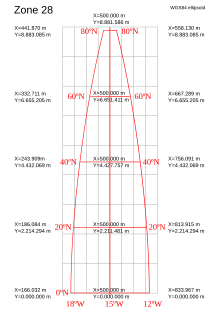
Back Ruitverwysing Afrikaans Malla de referencia Spanish Carroyage French Tagairt eangaí Irish Referensi grid ID Kartreferanse NB Caroiaj Romanian Grid reference SIMPLE Rehilya ng reperensiya Tagalog 投影坐标系 Chinese

| Geodesy |
|---|
 |
A projected coordinate system – also called a projected coordinate reference system, planar coordinate system, or grid reference system – is a type of spatial reference system that represents locations on Earth using Cartesian coordinates (x, y) on a planar surface created by a particular map projection.[1] Each projected coordinate system, such as "Universal Transverse Mercator WGS 84 Zone 26N," is defined by a choice of map projection (with specific parameters), a choice of geodetic datum to bind the coordinate system to real locations on the earth, an origin point, and a choice of unit of measure.[2] Hundreds of projected coordinate systems have been specified for various purposes in various regions.
When the first standardized coordinate systems were created during the 20th century, such as the Universal Transverse Mercator, State Plane Coordinate System, and British National Grid, they were commonly called grid systems; the term is still common in some domains such as the military that encode coordinates as alphanumeric grid references. However, the term projected coordinate system has recently become predominant to clearly differentiate it from other types of spatial reference system. The term is used in international standards such as the EPSG and ISO 19111 (also published by the Open Geospatial Consortium as Abstract Specification 2), and in most geographic information system software.[3][2]
- ^ Chang, Kang-tsung (2016). Introduction to Geographic Information Systems (9th ed.). McGraw-Hill. p. 34. ISBN 978-1-259-92964-9.
- ^ a b "OGC Abstract Specification Topic 2: Referencing by coordinates Corrigendum". Open Geospatial Consortium. Retrieved 2018-12-25.
- ^ "Using the EPSG geodetic parameter dataset, Guidance Note 7-1". EPSG Geodetic Parameter Dataset. Geomatic Solutions. Retrieved 15 December 2021.
© MMXXIII Rich X Search. We shall prevail. All rights reserved. Rich X Search